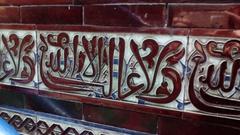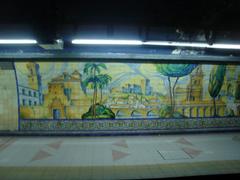
Independencia Buenos Aires Visiting Hours, Tickets, and Historical Sites Guide
Date: 15/06/2025
Introduction: The Heart of Argentina’s Independence
Independencia in Buenos Aires is a dynamic district steeped in the history of Argentina’s emergence as a sovereign nation. This area connects travelers with the nation’s pivotal past—from the early colonial period through the May Revolution of 1810 and the Declaration of Independence in 1816—while also immersing them in the vibrant rhythms of contemporary Buenos Aires. Here, colonial architecture, bustling urban life, and time-honored traditions merge, offering a vivid tapestry of Argentine identity.
Key landmarks such as Plaza de Mayo, Avenida Independencia, the Obelisco, and Plaza Independencia mark the city’s transformation from colonial outpost to modern metropolis. Visitors can delve into Argentina’s revolutionary history at sites like the Casa Rosada, Metropolitan Cathedral, and Palacio Barolo—all of which provide deep insight into the country’s journey toward freedom. This guide delivers detailed information on visiting hours, tickets, accessibility, and travel tips, ensuring a seamless and enriching experience.
Beyond the historical, Independencia is alive with cultural energy. From tango performances in storied dance halls to the aroma of traditional Argentine cuisine in local markets, every street tells a story. Major annual events, such as Independence Day on July 9th, showcase patriotic pride through parades and cultural festivities.
Whether you’re a history aficionado or a casual explorer, this comprehensive guide equips you with the essential knowledge to make the most of your visit to Independencia Buenos Aires. For personalized itineraries and up-to-date details, resources like the Buenos Aires Tourism Official Site and the Audiala app are invaluable.
Explore how the spirit of independence and the pulse of contemporary Buenos Aires intertwine in this unique district. (Enciclopedia Iberoamericana, Office Holidays, Expat Pathways)
Guide Contents
- Introduction
- Colonial Foundations and the Road to Independence
- The Declaration of Independence and Urban Legacy
- Key Historical Sites: Visiting Hours and Tickets
- Plaza de Mayo
- Palacio Barolo
- Avenida 9 de Julio
- San Telmo and Monserrat
- Special Events and Cultural Experiences
- Accessibility and Safety Tips
- Nearby Attractions and Guided Tours
- Plaza Independencia: Visitor Information
- The Obelisco: Practical Tips and Safety
- Plaza de Mayo: Hours, Tickets, and Essential Tips
- Frequently Asked Questions (FAQ)
- Conclusion and Call to Action
- References
Colonial Foundations and the Road to Independence
Independencia’s roots run deep in the colonial era, when Buenos Aires was the capital of the Viceroyalty of the Río de la Plata—a key administrative hub for Spanish South America (Enciclopedia Iberoamericana). The city’s strategic location made it a center of commerce and a hotbed of Enlightenment-inspired unrest. The May Revolution of 1810, spurred by instability in Spain, saw Buenos Aires establish its first autonomous government, the Primera Junta. This pivotal event set Argentina on the path to independence, culminating in the historic declaration of July 9, 1816, in Tucumán (Office Holidays).
The Declaration of Independence and Urban Legacy
The ideals of independence are etched into Buenos Aires’ urban fabric. Avenida Independencia, named to honor the 1816 declaration, traverses historic neighborhoods and stands as a living symbol of Argentina’s fight for self-determination (Expat Pathways). The avenue and adjoining areas are lined with architectural treasures and vibrant cultural venues, reflecting both the city’s revolutionary heritage and its modern vitality.
Key Historical Sites: Visiting Hours and Tickets
Plaza de Mayo
The city’s oldest square and the site of countless historic events, Plaza de Mayo is bordered by major landmarks:
- Casa Rosada: The presidential palace. Guided tours available on weekends; reserve via the official site.
- Metropolitan Cathedral: Open daily, 7:00 a.m. to 7:00 p.m. Free entry.
- Cabildo: Open Tuesday to Sunday, 10:00 a.m. to 5:00 p.m. Entry fee applies.
The plaza itself is open 24/7 and is free to access.
Palacio Barolo
A masterpiece inspired by Dante’s Divine Comedy, Palacio Barolo offers panoramic city views and guided tours:
- Hours: Tuesday to Sunday, 10:00 a.m. to 6:00 p.m.
- Tickets: Approx. ARS 700. Advance booking recommended.
Avenida 9 de Julio and the Obelisco
One of the world’s widest avenues, home to the iconic Obelisco and adjacent to museums and theaters. The avenue and monument are accessible at all hours; tickets may be required for nearby cultural sites.
San Telmo and Monserrat
These neighborhoods are known for cobblestone streets, colonial buildings, artisan markets, and street performances. Most attractions are outdoors and free to explore.
For current hours and ticket prices, always check official tourism sites or visitor centers. Discounts are often available for students, seniors, and groups.
Special Events and Cultural Experiences
Independence Day (July 9th) is celebrated with parades, cultural events, and traditional food fairs, especially along Avenida 9 de Julio and Plaza de Mayo (Office Holidays). The area also hosts the annual Tango Buenos Aires Festival, artisan markets, and frequent street performances. Photography is encouraged, but always respect the privacy of locals.
Accessibility and Safety Tips
Independencia is well-connected via the Subte (subway) and city buses. The area is generally safe, but standard urban precautions apply: stay alert in crowds, keep valuables secure, and avoid isolated areas late at night. Many sites offer wheelchair access—contact venues in advance for specific needs.
Nearby Attractions and Guided Tours
Enhance your experience with guided walking tours through Monserrat, San Telmo, and La Boca. These tours often include museums, historic cafés, and vibrant markets, providing deeper cultural context.
Visiting Plaza Independencia: Hours, Tickets & Nearby Attractions
Hours and Accessibility
Plaza Independencia is an open space accessible 24/7. Nearby museums have specific hours; check each venue’s website for updates.
Key Nearby Sites
- Museo Nacional de Bellas Artes: Tue–Sun, 12:00–20:00, free entry (Museo Nacional de Bellas Artes).
- Zanjón de Granados: Wed–Sun, 10:00–18:00, entry fee applies.
- Teatro Colón: Guided tours daily, 9:00–17:00, ticket purchase required (Teatro Colón Official Website).
Getting There
Accessible by Subte lines A, C, and E; multiple bus lines; taxis and rideshares.
Cultural Traditions
Experience tango in local milongas, sample asado and mate in cafés, and explore artisan markets in San Telmo.
Events
The area hosts festivals like the Tango Buenos Aires Festival and Feria de Mataderos, as well as weekly cultural gatherings in public spaces.
Visiting the Obelisco: Practical Tips and Safety
Hours and Access
The Obelisco is an outdoor monument in Plaza de la República, accessible 24/7. No entry fee required.
Getting There
Centrally located and reachable by Subte lines B, C, and D, as well as a variety of bus routes.
Nearby
Teatro Colón, Avenida Corrientes, and Plaza de Mayo are within walking distance.
Safety Tips
Stay alert to petty theft, avoid isolated areas late at night, and keep valuables secure. The area is well-lit and busy, especially during the day.
Visitor Tips
Early mornings and late afternoons are best for photos. The site is wheelchair accessible.
Plaza de Mayo: Hours, Tickets, and Visitor Tips
Plaza Access
Open 24/7, no admission fee.
Casa Rosada
Museum open Tue–Sun, 10:00–18:00. Entry is free, with advance registration advised (Casa Rosada Official Website).
Metropolitan Cathedral
Open daily, free entry.
Dining and Accommodation
Nearby options range from historic cafés to modern restaurants. Book accommodations early during national holidays.
Transport
Accessible via Subte Line A (Plaza de Mayo station), buses, taxis, and Ecobici bike system.
Unique Experiences
Attend the Mothers of Plaza de Mayo march (Thursdays), explore artisan markets, and photograph the Casa Rosada at sunset.
Frequently Asked Questions (FAQ)
Q: Are tickets required for key sites in Independencia?
A: Most outdoor spaces are free. Museums and guided tours may require tickets.
Q: When is the best time to visit?
A: Spring (October–November) and autumn (March–May) offer mild weather and fewer crowds.
Q: Is the area accessible?
A: Yes, most public areas and museums offer accessibility features.
Q: How do I get around?
A: Use the Subte, buses, taxis, or ride-sharing apps. The area is also walkable.
Q: Are guided tours recommended?
A: Yes, they provide valuable historical and cultural context.
Conclusion and Call to Action
Independencia Buenos Aires is a living chronicle of Argentina’s struggle and celebration of independence, blending historic landmarks with cultural vibrancy. From the political epicenter of Plaza de Mayo to the soaring Obelisco and atmospheric streets of San Telmo, this district invites visitors to experience the authentic spirit of Buenos Aires.
For the most rewarding journey, plan ahead—consult official resources, join guided tours, and use the Audiala app for curated tips and itineraries. Capture the moments, savor the traditions, and immerse yourself in one of South America’s most historic and captivating districts.
References and Official Resources
- Enciclopedia Iberoamericana
- Office Holidays – Argentina Independence Day
- Expat Pathways – Avenues in Buenos Aires
- Museo Nacional de Bellas Artes
- Teatro Colón Official Website
- Casa Rosada Official Website
- Buenos Aires Tourism Official Site
- Audiala App































































































































































